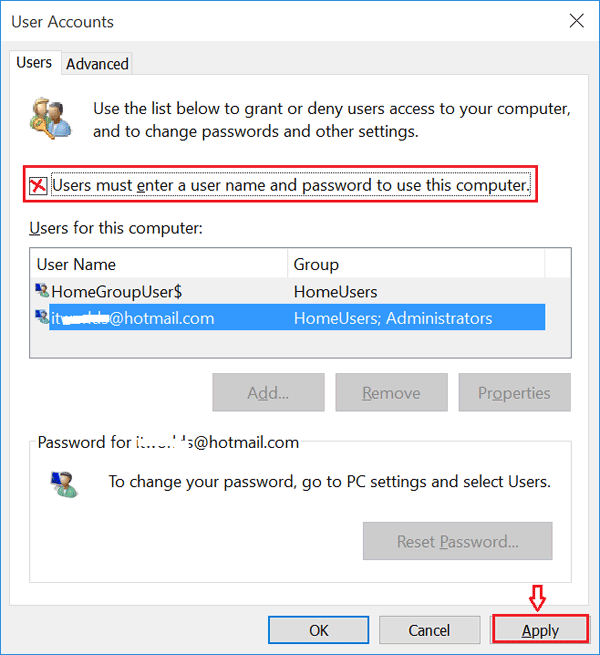
- I saw a list of usernames and passwords on windows 10 how to#
- I saw a list of usernames and passwords on windows 10 password#
Suppose the database D consists of 4 billion credentials, then after sharding each subset, it will contain about 60,000 credentials on average. When the browser submits a query, it will compute these two bytes from the username and send it along with the encrypted credentials. To optimize the performance of our protocol, we further shard the database D of breached credentials, according to the first two bytes of a certain hash function applied to the username. Check out both papers mentioned and linked earlier for a description of these optimizations and details on how the protocol works. We utilized many optimizations to achieve performance that scales to users’ needs. In the above framework, the main challenge is to minimize the complexity of the computeMatch function to obtain good performance when this function is evaluated on encrypted data. The server forwards the encrypted result to the client, who decrypts it and obtains the result. The matching function operation looks like this: computeMatch(Enc(k), D). The server then evaluates a matching function on the encrypted credential, obtaining a result (True or False) encrypted under the same client key. The client then uses homomorphic encryption to encrypt H(k) and send the resulting ciphertext Enc(H(k)) to the server. Since only the server knows the hash function H, the client is prevented from performing an efficient dictionary attack on the server, a type of brute force attack that uses a large combination of possibilities to determine a password. This is possible using a cryptographic primitive known as an O blivious Pseudo-Random Function (OPRF). However, if these ciphertexts are encrypted using homomorphic encryption, then there is a public operation that “adds” these ciphertexts and returns an encryption of 12, the sum of 5 and 7.įirst, the client communicates with the server to obtain a hash H of the credential, where H denotes a hash function that only the server knows. Normally, it does not make sense to “add” these ciphertexts together. For example, suppose we are given two ciphertexts, one encrypting 5 and the other encrypting 7. Homomorphic encryption is a relatively new cryptographic primitive that allows computing on encrypted data without decrypting the data first.
I saw a list of usernames and passwords on windows 10 password#
The protocol is based on the research done by the cryptography research team, presented in two papers: “ Fast Private Set Intersection from Homomorphic Encryption” and “ Labeled PSI from Fully Homomorphic Encryption with Malicious Security.” How Password Monitor secures your information For this, the Microsoft SEAL library was modified to support low-end devices, to have multi-platform support (Mac, ARM, x86), and to optimize the protocol for network efficiency. We want to ensure that every Edge user on every platform can trust and benefit from this feature. Microsoft Edge powers millions of users and supports a range of devices, old to new, with varying storage, computing power, and connectivity.
I saw a list of usernames and passwords on windows 10 how to#
It is also important to ensure that no outside party is able to gain access to this information while it travels between users and Edge servers (as in man-in-the-middle attacks).To learn how to enable Password Monitor in the Edge browser and access a list of frequently asked questions, read the Password Monitor support page.įast Private Set Intersection from Homomorphic Encryptionįrom the onset, this was a huge challenge for the teams. The most important aspect is that the Edge servers must never learn any information about the client’s usernames or passwords. It is also necessary to periodically check this in case there are new instances of breached passwords found. The teams have built on the Microsoft SEAL homomorphic encryption library to implement a new protocol to bring Password Monitor to our Edge users.Īt a high level, when a password is saved in Edge, the browser needs to contact a server to check if the password was found in a breached list. It is the result of a collaboration between former research incubation group, the Cryptography and Privacy Research Group, and Edge product team. The feature is a culmination of our research on homomorphic encryption and its practical applications. This unique security feature is possible due to pioneering cryptography research and technology incubation done here at Microsoft Research. The underlying technology ensures privacy and security of the user’s passwords, which means that neither Microsoft nor any other party can learn the user’s passwords while they are being monitored. All this is done while ensuring Microsoft doesn’t learn the user’s passwords.


The feature notifies users if any of their saved passwords have been found in a third-party breach. Today, to further bolster that trust while keeping our customers safe, we introduce a new feature called Password Monitor. One of the biggest pillars for Microsoft Edge is trust.


 0 kommentar(er)
0 kommentar(er)
